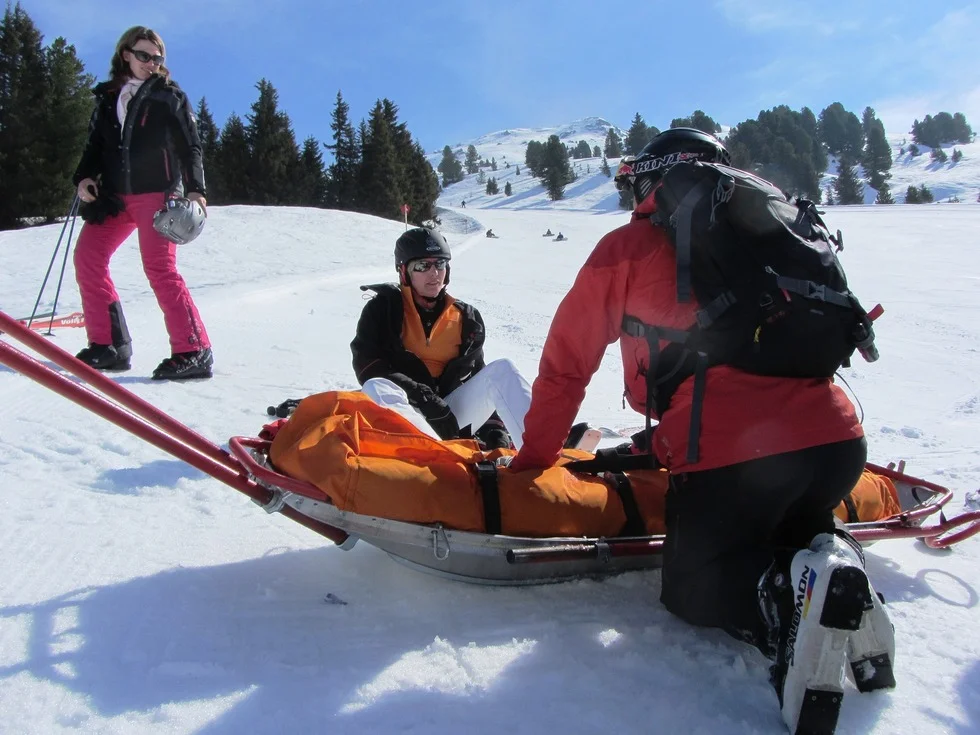Flagstaff Ski Accident Lawyer

Ski Accident Attorney in Flagstaff, AZ
Skiing and winter sports are popular recreation activities in Northern Arizona. However, when ski or snowboard accidents happen on the mountain, it can be difficult to determine if it is possible to pursue compensation through a personal injury claim.
Ski resort owners are responsible for creating and maintaining a safe recreation environment. Their duties include posting clear and appropriate signage that communicates warnings, rules, boundaries, and notices. Owners are also responsible for properly maintaining their equipment and facility. If the resort fails to uphold these responsibilities and injuries happen as a result, there may be grounds for a personal injury claim.
In many cases, the ski resort is not at fault, and responsibility instead falls on the negligent actions of a skier or snowboarder. However, the fault is not always present in an accident. There are many instances where even though an accident did happen, negligent behavior is absent, thus no one is at fault.
Keep reading for some general information about how negligence, ski accidents, and personal injury claims tie together, as well as some tips on what to do if you find yourself in such an accident. Each case is unique, so if you need detailed information about how your ski or snowboard accident relates to a personal injury claim, get in touch with an experienced attorney.
Understanding negligence relating to ski or snowboard accidents
As stated above, not every ski or snowboard accident is viable for a personal injury claim. To receive compensation for damages, there must be negligence. Negligence is apparent when someone fails to conduct themselves in a careful way. Behaviors that are reckless and inconsiderate of safety are negligent, and if those actions lead to an accident, liability can be assigned.
There is a code of conduct that demonstrates what safe behavior is for skiers and snowboarders. In general, safety policy at ski resorts includes the same basic expectations for safe ski and snowboard recreation. Below are the safety policies at Arizona Snowbowl:
- Think rationally while skiing or snowboarding. Understand that there are numerous types of recreators sharing the mountain and that reducing risk stems from showing courtesy to others, maintaining personal awareness, and using common sense
- Understand your limits and ski or snowboard within your ability
- Always maintain control and be prepared to stop or avert other people or obstructions on a run
- Be aware of those ahead of you on a trail and understand that they have the right of way. It is the uphill person’s responsibility to avoid those downhill
- Do not stop in a place that blocks a trail or is not visible to uphill skiers or snowboarders
- Before you start moving downhill or when you are merging onto a trail, inspect what is happening uphill. Yield to others moving downhill, and ensure it is clear for you to safely start moving.
- Limit the chances of runaway equipment by using safety devices
Actions that do not coincide with these safety policies, such as moving at a speed where it’s impossible to quickly stop or avoid someone, would be negligent behavior. Reckless behavior can also include skiing or snowboarding under the influence or ignoring safety signs.
What is not negligence
There are cases where accidents happen without negligence. In these instances, all parties involved exercise the appropriate degree of care. For example, say two amateur skiers are learning to turn on the beginner slope. Both are going slow and using caution, yet one still manages to slide into the other. In this example, the collision was not the responsibility of either skier, as they were both moving with care.
Proving liability: A look at the elements of negligence
So, how do you determine if you can collect compensation for damages that were incurred from a ski or snowboard accident? Of course, an attorney will provide the best answer to that question based on your specific experience. However, there are elements of negligence, and if your case satisfies the qualifications of these elements, then you likely can move forward with a personal injury claim.
Duty of care
To establish if negligence is involved, a good place to begin is establishing the duty of care. To satisfy the duty of care, your case needs to demonstrate that the party in question had a legal obligation to you. In a ski accident example, a skier’s duty of care is to avoid accidents by practicing safe behavior, such as giving downhill traffic the right of way on a run.
Breach of duty
The breach of duty element comes after establishing the duty of care. Here, your case must demonstrate that the other party violated the duty of care that they owed you. In the context of a ski accident, a skier or snowboarder could breach their duty of care by not yielding to downhill traffic, and their actions resulted in a collision. Proof is important here, as your case must clearly substantiate that a breach of duty occurred through evidence, such as eyewitness testimony.
Causation
The third element that your case must establish is causation, which means that the breach of duty was the main cause of the accident. Here, your case must demonstrate that any damages you suffered were a direct result of the other party’s reckless behavior. If the accident had occurred regardless of the other party’s actions, then this element of negligence would be difficult to prove.
Damages
The last negligence element involves proving that you suffered from the accident. This is where your case will demonstrate that you suffered economic and non-economic damages, which include physical injuries, medical bills, lost income, and more. Your case must be able to directly tie your damages with the events of the accident.
What to do in the event of a ski or snowboard accident in Flagstaff, AZ
The actions you take after experiencing a ski accident are extremely important. In the context of pursuing compensation, evidence is helpful to prove that all four elements of negligence existed in the incident. It’s understandable that after enduring an accident, you may not be in a position to gather evidence yourself. The first thing you should do is see to your injuries and make sure that you and the other party are physically okay and safe. Then, if you are able to, or if someone can act on your behalf, some additional steps can be taken to strengthen a personal injury claim:
- Make contact with ski patrol, and ensure that an authority figure comes to the scene and takes down a report. Having an official account of what happened right after the incident is useful evidence
- Exchange information with the person who hit you– take down their name and contact details
- At the site, snap away and take a good deal of pictures. Be sure to take shots from numerous angles, including above the scene and below. If possible, try to take pictures of your tracks and the other party’s tracks in the snow. Take pictures of yourself, all equipment, and all injuries
- Seek medical help for your injuries. Insurance companies do take notice of delays in medical treatment when reviewing claims, so you want to ensure that you get yourself on the road to healing as soon as possible
- Collect and keep track of all documentation. Keep track of all medical documents and bills, any documents that point to a loss of income, and keep a journal about the healing process as you recover from your injuries
- Consult with legal representation as quickly as you can. A knowledgeable Flagstaff personal injury attorney will act as a guide through this process. They will help you organize your case, consult with you on what measures need to be taken, and deal with all legal issues on your behalf. Building a strong claim can be akin to building a house; constructing a solid foundation for your case will go a long way in receiving as much compensation for your accident as possible. An attorney will help you build this foundation
Get help by contacting Glazer, Hammond & Smets, PLLC
The attorneys at Glazer, Hammond & Smets, PLLC understand how difficult pursuing legal action can be. Personal injury attorney Keith Hammond has the experience, reputation, and skill set to take the burden off of your shoulders and get you the compensation you are owed.
Being the victim of negligence is hard enough, but you don’t have to go through the personal injury process alone. Get in touch with Glazer, Hammond & Smets, PLLC, and take the first steps towards compensation today.






